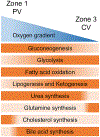Molecular regulation of mammalian hepatic architecture
- PMID: 30797519
- PMCID: PMC6590693
- DOI: 10.1016/bs.ctdb.2018.12.003
Molecular regulation of mammalian hepatic architecture
Abstract
The essential liver exocrine and endocrine functions require a precise spatial arrangement of the hepatic lobule consisting of the central vein, portal vein, hepatic artery, intrahepatic bile duct system, and hepatocyte zonation. This allows blood to be carried through the liver parenchyma sampled by all hepatocytes and bile produced by the hepatocytes to be carried out of the liver through the intrahepatic bile duct system composed of cholangiocytes. The molecular orchestration of multiple signaling pathways and epigenetic factors is required to set up lineage restriction of the bipotential hepatoblast progenitor into the hepatocyte and cholangiocyte cell lineages, and to further refine cell fate heterogeneity within each cell lineage reflected in the functional heterogeneity of hepatocytes and cholangiocytes. In addition to the complex molecular regulation, there is a complicated morphogenetic choreography observed in building the refined hepatic epithelial architecture. Given the multifaceted molecular and cellular regulation, it is not surprising that impairment of any of these processes can result in acute and chronic hepatobiliary diseases. To enlighten the development of potential molecular and cellular targets for therapeutic options, an understanding of how the intricate hepatic molecular and cellular interactions are regulated is imperative. Here, we review the signaling pathways and epigenetic factors regulating hepatic cell lineages, fates, and epithelial architecture.
Keywords: Bile duct development; Biliary system; Cholangiocyte; Hepatoblast; Hepatocyte zonation; Liver development.
© 2019 Elsevier Inc. All rights reserved.
Figures










Similar articles
-
The homeobox gene Hhex is essential for proper hepatoblast differentiation and bile duct morphogenesis.Dev Biol. 2007 Aug 15;308(2):355-67. doi: 10.1016/j.ydbio.2007.05.028. Epub 2007 May 25. Dev Biol. 2007. PMID: 17580084 Free PMC article.
-
Cell lineage analysis during liver development using the spf(ash)-heterozygous mouse.Lab Invest. 2001 Jan;81(1):17-25. doi: 10.1038/labinvest.3780208. Lab Invest. 2001. PMID: 11204270
-
Van Gogh-like 2 is essential for the architectural patterning of the mammalian biliary tree.J Hepatol. 2024 Jul;81(1):108-119. doi: 10.1016/j.jhep.2024.02.030. Epub 2024 Mar 7. J Hepatol. 2024. PMID: 38460794
-
Biliary differentiation and bile duct morphogenesis in development and disease.Int J Biochem Cell Biol. 2011 Feb;43(2):245-56. doi: 10.1016/j.biocel.2009.07.020. Epub 2009 Sep 6. Int J Biochem Cell Biol. 2011. PMID: 19735739 Review.
-
Molecular mechanisms of biliary development.Prog Mol Biol Transl Sci. 2010;97:103-26. doi: 10.1016/B978-0-12-385233-5.00004-0. Prog Mol Biol Transl Sci. 2010. PMID: 21074731 Review.
Cited by
-
Cellular and transcriptional heterogeneity in the intrahepatic biliary epithelium.Gastro Hep Adv. 2023;2(1):108-120. doi: 10.1016/j.gastha.2022.07.015. Epub 2022 Aug 5. Gastro Hep Adv. 2023. PMID: 36593993 Free PMC article.
-
IFT-A deficiency in juvenile mice impairs biliary development and exacerbates ADPKD liver disease.J Pathol. 2021 Jul;254(3):289-302. doi: 10.1002/path.5685. Epub 2021 May 21. J Pathol. 2021. PMID: 33900625 Free PMC article.
-
Management of adults with Alagille syndrome.Hepatol Int. 2023 Oct;17(5):1098-1112. doi: 10.1007/s12072-023-10578-x. Epub 2023 Aug 16. Hepatol Int. 2023. PMID: 37584849 Free PMC article. Review.
-
Applications of human organoids in the personalized treatment for digestive diseases.Signal Transduct Target Ther. 2022 Sep 27;7(1):336. doi: 10.1038/s41392-022-01194-6. Signal Transduct Target Ther. 2022. PMID: 36167824 Free PMC article. Review.
-
Human liver model systems in a dish.Dev Growth Differ. 2021 Jan;63(1):47-58. doi: 10.1111/dgd.12708. Epub 2021 Feb 2. Dev Growth Differ. 2021. PMID: 33423319 Free PMC article. Review.
References
-
- Amemiya-Kudo M, Shimano H, Hasty AH, Yahagi N, Yoshikawa T, Matsuzaka T, et al. (2002). Transcriptional activities of nuclear SREBP−1a, −1c, and −2 to different target promoters of lipogenic and cholesterogenic genes. Journal of Lipid Research, 43, 1220–1235. - PubMed
-
- Aoki R, Chiba T, Miyagi S, Negishi M, Konuma T, Taniguchi H, et al. (2010). The polycomb group gene product Ezh2 regulates proliferation and differentiation of murine hepatic stem/progenitor cells. Journal of Hepatology, 52, 854–863. - PubMed
Publication types
MeSH terms
Grants and funding
LinkOut - more resources
Full Text Sources

